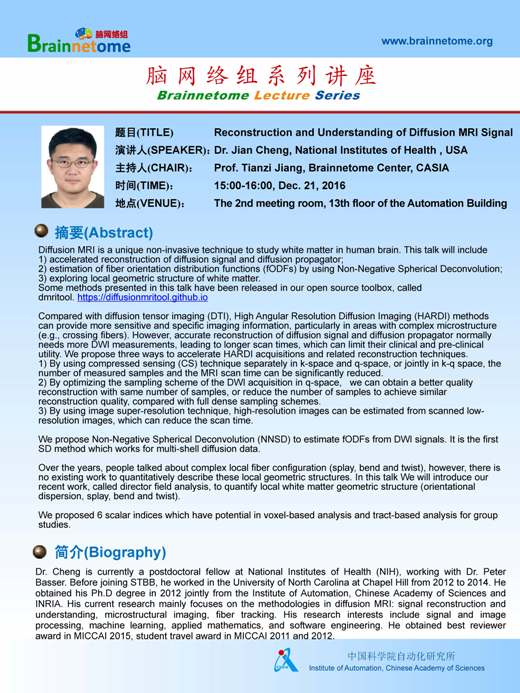Dr. Jian Cheng's Lecture: Reconstruction and Understanding of Diffusion MRI Signal
Title: Reconstruction and Understanding of Diffusion MRI Signal
Speaker: Dr. Jian Cheng, National Institutes of Health , USA
Chair: Prof. Tianzi Jiang, Brainnetome Center, CASIA
Time: 15:00-16:00 Dec. 21, 2016
Venue: The 2nd meeting room, 13th floor of the Automation Building
[Abstract]
Diffusion MRI is a unique non-invasive technique to study white matter in human brain. This talk will include
1) accelerated reconstruction of diffusion signal and diffusion propagator;
2) estimation of fiber orientation distribution functions (fODFs) by using Non-Negative Spherical Deconvolution;
3) exploring local geometric structure of white matter. Some methods presented in this talk have been released in our open source toolbox, called dmritool. https://diffusionmritool.github.io
Compared with diffusion tensor imaging (DTI), High Angular Resolution Diffusion Imaging (HARDI) methods can provide more sensitive and specific imaging information, particularly in areas with complex microstructure (e.g., crossing fibers). However, accurate reconstruction of diffusion signal and diffusion propagator normally needs more DWI measurements, leading to longer scan times, which can limit their clinical and pre-clinical utility. We propose three ways to accelerate HARDI acquisitions and related reconstruction techniques.
1) By using compressed sensing (CS) technique separately in k-space and q-space, or jointly in k-q space, the number of measured samples and the MRI scan time can be significantly reduced.
2) By optimizing the sampling scheme of the DWI acquisition in q-space, we can obtain a better quality reconstruction with same number of samples, or reduce the number of samples to achieve similar reconstruction quality, compared with full dense sampling schemes.
3) By using image super-resolution technique, high-resolution images can be estimated from scanned low-resolution images, which can reduce the scan time.
We propose Non-Negative Spherical Deconvolution (NNSD) to estimate fODFs from DWI signals. It is the first SD method which works for multi-shell diffusion data.
Over the years, people talked about complex local fiber configuration (splay, bend and twist), however, there is no existing work to quantitatively describe these local geometric structures. In this talk We will introduce our recent work, called director field analysis, to quantify local white matter geometric structure (orientational dispersion, splay, bend and twist).
We proposed 6 scalar indices which have potential in voxel-based analysis and tract-based analysis for group studies.
[Biography]
Dr. Cheng is currently a postdoctoral fellow at National Institutes of Health (NIH), working with Dr. Peter Basser. Before joining STBB, he worked in the University of North Carolina at Chapel Hill from 2012 to 2014. He obtained his Ph.D degree in 2012 jointly from the Institute of Automation, Chinese Academy of Sciences and INRIA. His current research mainly focuses on the methodologies in diffusion MRI: signal reconstruction and understanding, microstructural imaging, fiber tracking. His research interests include signal and image processing, machine learning, applied mathematics, and software engineering. He obtained best reviewer award in MICCAI 2015, student travel award in MICCAI 2011 and 2012.

